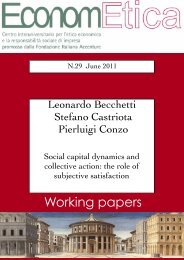WP15 November 2009 - Econometica
WP15 November 2009 - Econometica
WP15 November 2009 - Econometica
You also want an ePaper? Increase the reach of your titles
YUMPU automatically turns print PDFs into web optimized ePapers that Google loves.
in repeated (Capra et al. 1999) Traveler’s Dilemma. Rubinstein (2007) showed that around 50<br />
percent of more than 4.500 subjects who played an online version of the Traveler’s Dilemma<br />
(henceforth also TD) opted for the maximum choice (the minimum and maximum choice allowed<br />
were 180$ and 300$ respectively and P|R was 5$). 1<br />
The payoff structure of the Traveler’s Dilemma – which is characterized by a large suboptimality<br />
of the Nash equilibrium with respect to the cooperative outcome - makes it a suitable<br />
game to experimentally approach the idea of team reasoning, that has been proposed in different<br />
terms by David Hodgson (1967), Donald Regan (1980), Margaret Gilbert (1989), Susan Hurley<br />
(1989), Robert Sugden (1993, 2000, 2003), Martin Hollis (1998) and Michael Bacharach (1997,<br />
1999, 2006). The aim of this paper is not to present the various approaches to team reasoning (to<br />
this aim see Gold and Sugden 2008). Our analysis is aimed at empirically verifying the role of<br />
“common reason to believe” (Sugden 2003) and of framing (Bacharach 1999 and 2006) within the<br />
theory of team reasoning. We provide an original empirical test of disputed theoretical questions<br />
related to the internal logic of team reasoning and to the reason explaining its endorsement by the<br />
members of a group.<br />
In section 2, after having stressed the common thread characterizing the theory of team<br />
reasoning, we: a) discuss the idea of common reason to believe within this theory (Sugden 2003); b)<br />
discuss the role of framing in prompting the endorsement of team reasoning according to the<br />
Bacharach’s approach; c) present in detail our empirical aims connected to these two theoretical<br />
issues. In section 3, we illustrate the rationale of our experiment and describe its design. In section 4<br />
and 5 we empirically analyze the ideas of common reason to believe and framing within the theory<br />
of team reasoning respectively. Section 6 concludes.<br />
1 Subjects who participated in the online experiment were not paid. However, Rubinstein stresses that the distribution of<br />
answers given by these subjects is similar to that of Goeree and Holt (2001) when they use the low P|R.<br />
3



